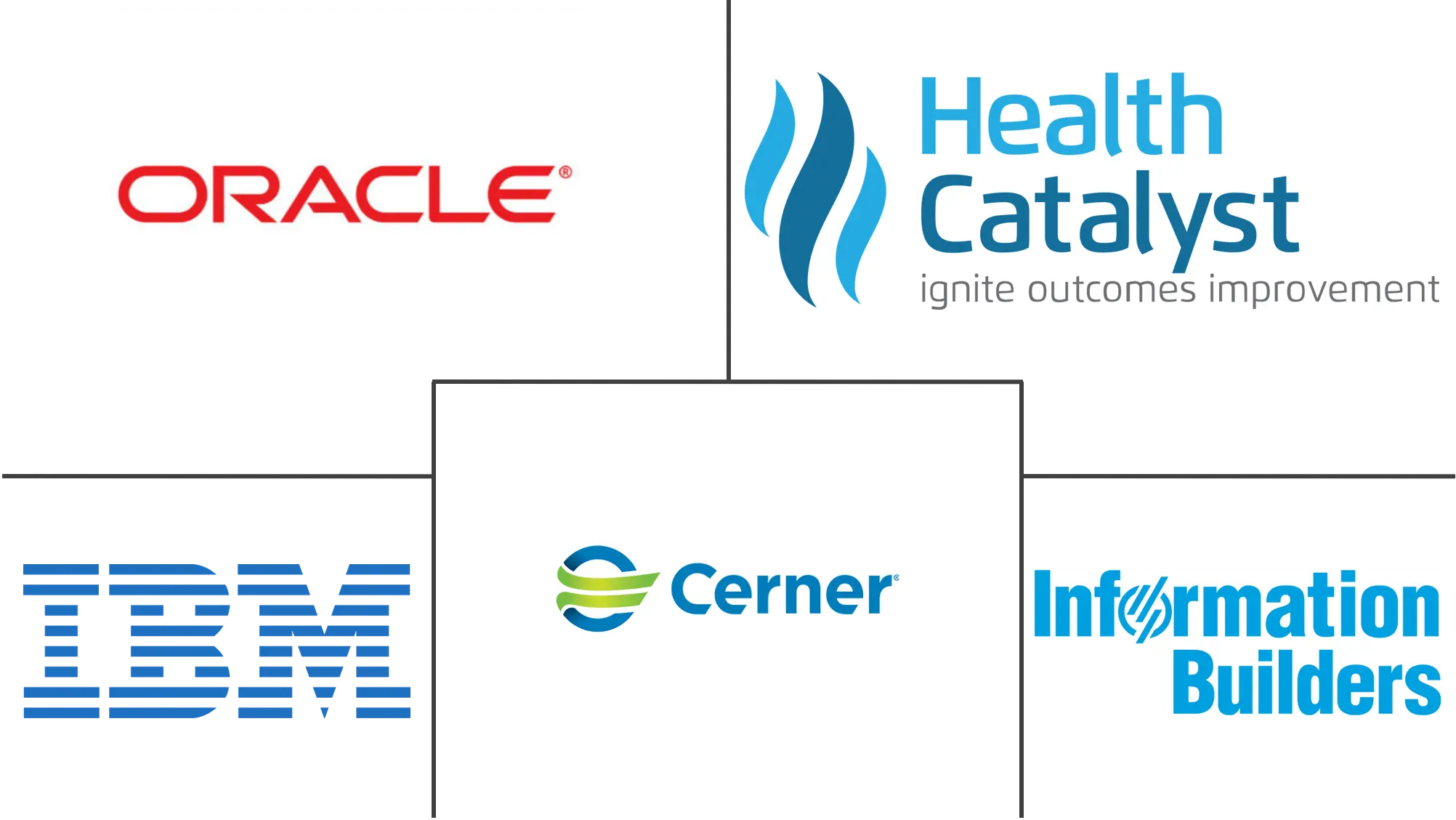Healthcare Predictive Analytics Market Size and Share
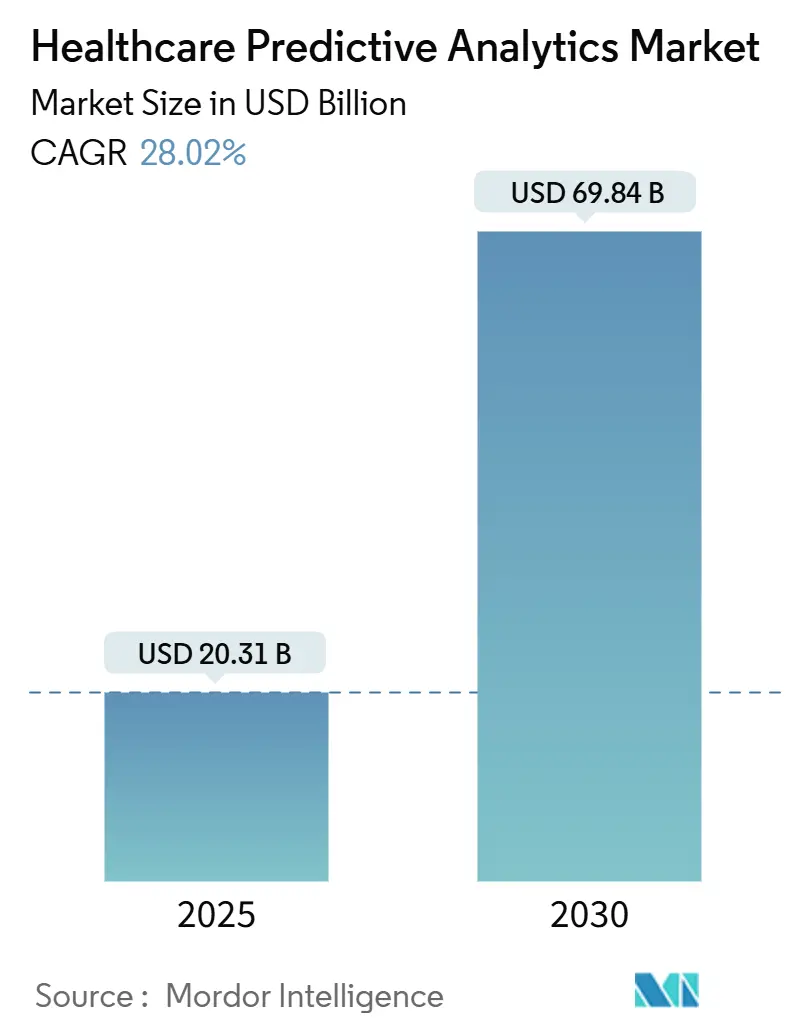
Healthcare Predictive Analytics Market Analysis by Mordor Intelligence
The Healthcare Predictive Analytics Market size is estimated at USD 20.31 billion in 2025, and is expected to reach USD 69.84 billion by 2030, at a CAGR of 28.02% during the forecast period (2025-2030).
Rapid uptake of AI-enabled clinical decision support, growing cloud infrastructure, and regulatory clarity from the United States Food and Drug Administration (FDA) anchor this expansion. Real-time data from electronic health records (EHRs), wearables, and connected medical devices supplies the raw material for increasingly accurate risk models, while payers link reimbursement to measurable outcomes. Established EHR vendors integrate native analytics to lock in existing clients, and specialist firms compete with synthetic data tools that address rare-event prediction challenges. Regional adoption varies: North America currently leads, but Asia-Pacific’s digitization programs, including national cloud-first policies, signal the next demand surge for the healthcare predictive analytics market.
Key Report Takeaways
- By application, financial data analytics held 27.92% of the healthcare predictive analytics market share in 2024; clinical data analytics is projected to expand at a 30.52% CAGR through 2030.
- By analytics type, descriptive analytics led with 51.43% revenue share in 2024, while cognitive analytics is advancing at a 37.47% CAGR to 2030.
- By component, services accounted for 47.74% of the healthcare predictive analytics market size in 2024 and will grow at a 29.84% CAGR through 2030.
- By mode of delivery, on-premise solutions commanded 61.34% share of the healthcare predictive analytics market size in 2024, whereas cloud-based deployment is rising at a 34.71% CAGR to 2030.
- By geography, North America led with 38.12% revenue share in 2024; Asia-Pacific records the highest projected CAGR at 31.71% through 2030.
Global Healthcare Predictive Analytics Market Trends and Insights
Drivers Impact Analysis
| Driver | (~) % Impact on CAGR Forecast | Geographic Relevance | Impact Timeline |
|---|---|---|---|
| Personalized & Evidence-Based Medicine Adoption | +6.2% | Global, with North America & EU leading implementation | Medium term (2-4 years) |
| Efficiency Pressure from Value-Based Reimbursement Models | +5.8% | North America core, expanding to APAC & Europe | Short term (≤ 2 years) |
| Need to Curb Avoidable Healthcare Expenditure | +4.1% | Global, particularly acute in high-cost markets | Long term (≥ 4 years) |
| Proliferation of IoT / Wearable Data Streams | +7.3% | APAC leading adoption, North America & EU following | Medium term (2-4 years) |
| Integration of Social-Determinant Datasets into Models | +2.9% | North America & EU focus, emerging in APAC | Long term (≥ 4 years) |
| Rapid Growth of Synthetic Data Tools for Rare-Event Prediction | +3.4% | Global, with regulatory leadership in North America | Medium term (2-4 years) |
| Source: Mordor Intelligence | |||
Personalized & Evidence-Based Medicine Adoption
Providers embed multi-omic and social-determinant inputs into risk engines, advancing precision therapies and reducing adverse events. FDA guidance issued in 2025 outlines lifecycle controls that encourage transparent, bias-mitigated algorithms.[1]U.S. Food and Drug Administration, “Artificial Intelligence-Enabled Device Software Functions: Lifecycle Management and Marketing Submission Recommendations,” fda.gov Large academic centers now allocate nearly half of AI budgets to personalized monitoring and diagnostics solutions.[2]Mayo Clinic, “Advancing AI investment for diagnostics,” mayoclinic.org Genomic-EHR integration accelerates oncology breakthroughs, and early adopters report higher patient engagement scores due to more individualized care plans.
Efficiency Pressure from Value-Based Reimbursement Models
Alternative payment arrangements reward outcome improvements and cost containment, pushing real-time risk stratification into daily workflows. CMS incentives in the United States spur rapid deployments that demonstrate double-digit operating margin gains.[3]Centers for Medicare & Medicaid Services, “Innovation Center Alternative Payment Models,” cms.gov Health systems use predictive triage to prevent unplanned admissions and coordinate post-acute services, achieving documented returns on analytics investments above 120%. Timely alerts also aid staffing optimization, reducing overtime expenses that escalated after 2022 labor shortages.
Need to Curb Avoidable Healthcare Expenditure
Analytics quantify preventable costs tied to readmissions, duplicate testing, and unmanaged chronic conditions. Regional hospitals employing AI-enabled discharge planning tools cite a 25% relative decline in 30-day readmissions and lower per-patient spend. Forecasting modules align supply inventories with surgical schedules, cutting waste and freeing capital for patient-facing initiatives. Operational dashboards help executives track savings in near real time, bolstering the business case for expanded deployments.
Proliferation of IoT / Wearable Data Streams
Continuous physiologic feeds from connected devices extend monitoring beyond clinical walls and enrich predictive models with longitudinal data. Diabetes platforms forecast glucose trends hours ahead, and cardiac risk scores trigger early outpatient interventions. Cloud scalability supports quadruple the patient load versus legacy telemetry, and federated learning techniques preserve privacy while aggregating insight across institutions.
Restraints Impact Analysis
| Restraint | (~) % Impact on CAGR Forecast | Geographic Relevance | Impact Timeline |
|---|---|---|---|
| Inadequate Enterprise-Grade Data Infrastructure | -4.7% | Global, particularly acute in smaller healthcare systems | Short term (≤ 2 years) |
| Shortage of Analytics-Savvy Healthcare Professionals | -3.2% | Global, with severe shortages in specialized roles | Medium term (2-4 years) |
| Heightened Regulatory Scrutiny Over Algorithmic Bias | -2.1% | North America & EU leading regulatory frameworks | Long term (≥ 4 years) |
| Interoperability Gaps for Unstructured & Genomics Data | -1.8% | Global, with varying standards adoption rates | Medium term (2-4 years) |
| Source: Mordor Intelligence | |||
Inadequate Enterprise-Grade Data Infrastructure
Fragmented architectures hinder dataset consolidation, with 94% of executives flagging upgrades as a top-three priority in 2024. Only 28% report high organizational data literacy, slowing model operationalization. Smaller hospitals struggle to finance cloud migrations or high-performance compute nodes critical for real-time inference, extending project timelines and limiting early clinical wins.
Shortage of Analytics-Savvy Healthcare Professionals
Demand for clinicians who can interpret machine learning outputs far outstrips supply. Public health agencies recruit data scientists to plug expertise gaps, yet training pipelines lag. Talent shortages inflate consulting bills, raising total cost of ownership for first-time buyers and heightening the risk of under-used platforms that fail to affect frontline practice.
Segment Analysis
By Application: Clinical Analytics Gains Momentum amid Financial Stronghold
Financial analytics retained 27.92% of the healthcare predictive analytics market in 2024, driven by revenue cycle optimization and fraud detection. The segment remains vital because capitated contracts penalize coding errors and denials. In parallel, the healthcare predictive analytics market size for clinical analytics is projected to climb at a 30.52% CAGR, reflecting provider intent to close outcome gaps and personalize therapy. Clinical deployments span sepsis alerts, mortality prediction, and operating-room scheduling, generating measurable improvements in patient safety and resource use.
Continued investment in synthetic data augments rare-disease modeling a tuberculosis study achieved 91% diagnostic accuracy and this capability is now bundled into wider clinical analytics suites. Population health modules aggregate claims, pharmacy, and social-determinant inputs, supporting proactive outreach. Operations and supply-chain applications add incremental value by trimming inventory carry costs and balancing surgical caseloads, rounding out a diversified demand profile that supports long-run expansion of the healthcare predictive analytics market.
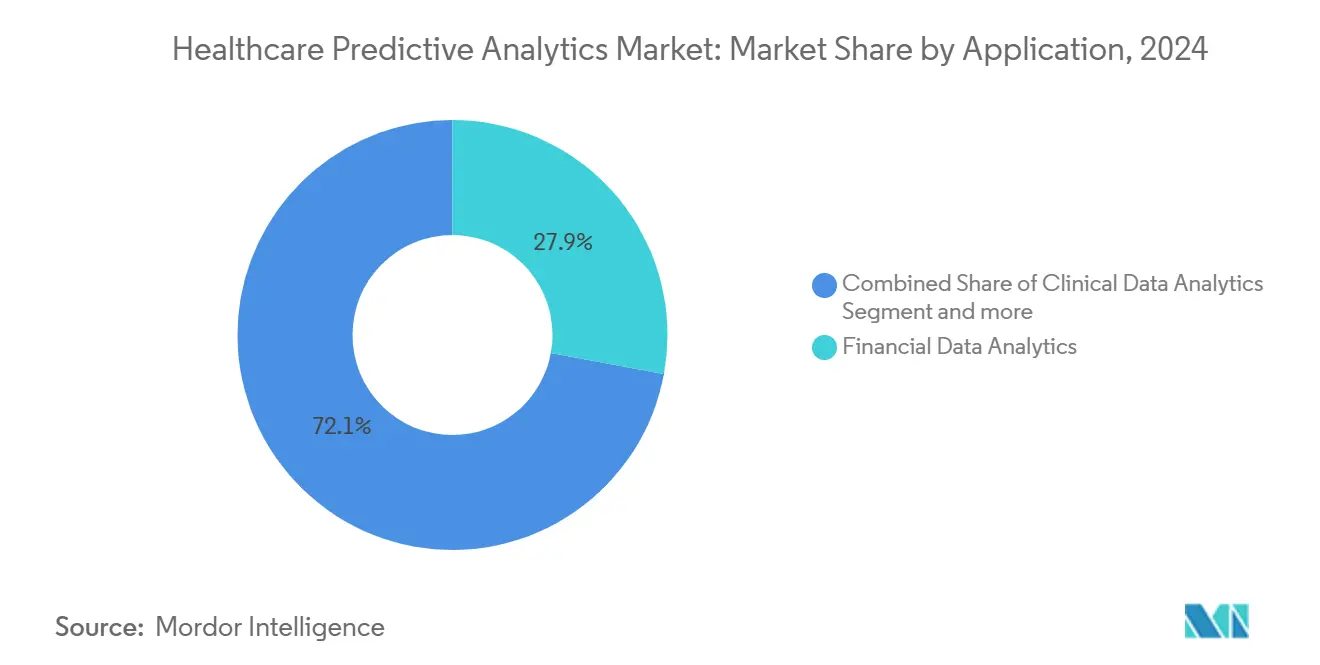
Note: Segment shares of all individual segments available upon report purchase
By Analytics Type: Cognitive Approaches Disrupt Descriptive Dominance
Descriptive tools held 51.43% revenue share of the healthcare predictive analytics market in 2024 as organizations sought basic visibility into historical performance. Those platforms act as feeders for advanced techniques, but maturity is shifting. The healthcare predictive analytics market size attributed to cognitive analytics will expand at a 37.47% CAGR, underpinned by natural language processing that parses unstructured notes and generative AI that drafts patient summaries.
Regulatory guardrails now permit adaptive algorithms, accelerating the migration from static scorecards to agentic AI that proposes interventions. Explainability remains essential: vendors embed interpretable layers that trace variable influence, satisfying compliance teams. Prescriptive modules, still nascent, recommend medication titration or staffing changes. Peer benchmarking suggests early users cut decision cycles by one-third, favoring deeper enterprise roll-outs.
By Component: Service-Led Implementations Dominate
Services captured 47.74% of healthcare predictive analytics market share in 2024 and is projected to climb at a 29.84% CAGR, a testament to the implementation complexity inside regulated clinical environments. Engagements cover data readiness audits, model development, and long-term monitoring. Consultancy-led change management speeds clinician adoption and mitigates alert fatigue. Software platforms account for the remainder, supplying model libraries, workflow APIs, and governance dashboards that standardize updates.
As more systems embrace cloud-first policies, managed services layered atop platform-as-a-service offerings gain traction. Providers appreciate consumption-based billing that aligns costs with realized value. Hardware spend remains the smallest slice yet funds accelerators for deep learning workloads and edge gateways that capture bedside device streams. This mix reinforces the service-centric trajectory of the healthcare predictive analytics market.
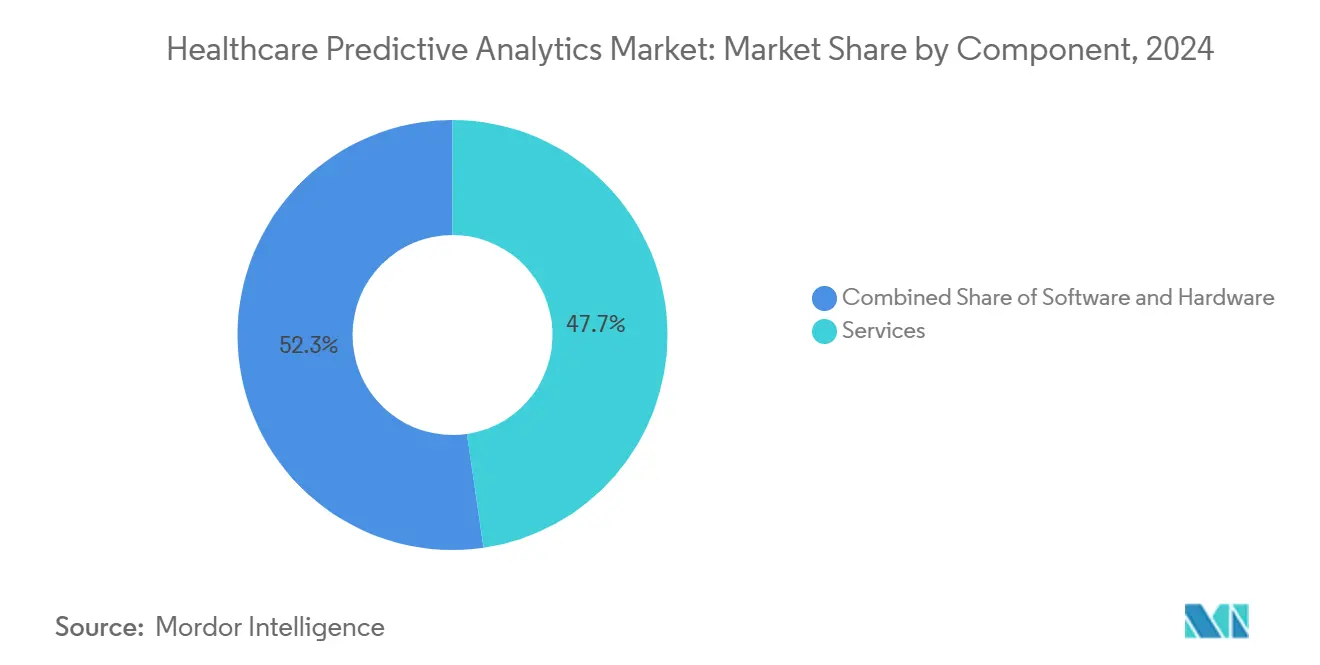
Note: Segment shares of all individual segments available upon report purchase
By Mode of Delivery: Cloud Uptake Accelerates While On-Premise Holds Majority
On-premise installations commanded 61.34% of revenue in 2024, reflecting legacy data-center investments and local-control preferences for protected health information. Latency-sensitive inference engines for acute-care settings also favor on-site deployment. Meanwhile, the healthcare predictive analytics market size tied to cloud solutions is forecast to rise at a 34.71% CAGR, unlocking elastic compute for compute-intensive training jobs and cross-facility data aggregation.
Hybrid architectures bridge regulatory concerns and scalability by retaining identifiable data locally while pushing anonymized derivatives to public clouds for federated modeling. Cloud-native tools shorten implementation timelines by automating provisioning and security hardening. They also support zero-downtime updates so that new evidence can refresh model parameters without interrupting clinician workflows, a critical capability in fast-moving therapeutic areas.
Geography Analysis
North America generated 38.12% of 2024 global revenue for the healthcare predictive analytics market, buoyed by widespread EHR penetration, CMS quality incentives, and proactive FDA oversight. Leading integrated delivery networks deploy multi-disciplinary analytics teams that span clinical, financial, and operational domains, producing validated models that feed hospital command centers. Average returns on analytics investments exceed 120%, reinforcing recurrent budgeting.
Europe follows with well-funded national digitization plans and the European Union AI Act, which prioritizes data protection and algorithmic transparency. Germany, the United Kingdom, and France support government grants that offset start-up costs and accelerate vendor certification. Ethical review boards further insulate deployments from public trust erosion, though administratively heavy processes slow commercialization relative to US timelines.
Asia-Pacific is projected to record a 31.71% CAGR through 2030, making it the growth epicenter of the healthcare predictive analytics market. National payer reforms in China, Japan, and India underwrite telehealth, cloud hosting, and AI research, catalyzing mass adoption. Public-private partnerships upgrade hospital IT estates, and regional cloud providers localize data centers to comply with sovereignty laws. Strategic roadmaps prioritize predictive analytics for disease surveillance and disaster preparedness, cementing long-term regional momentum.
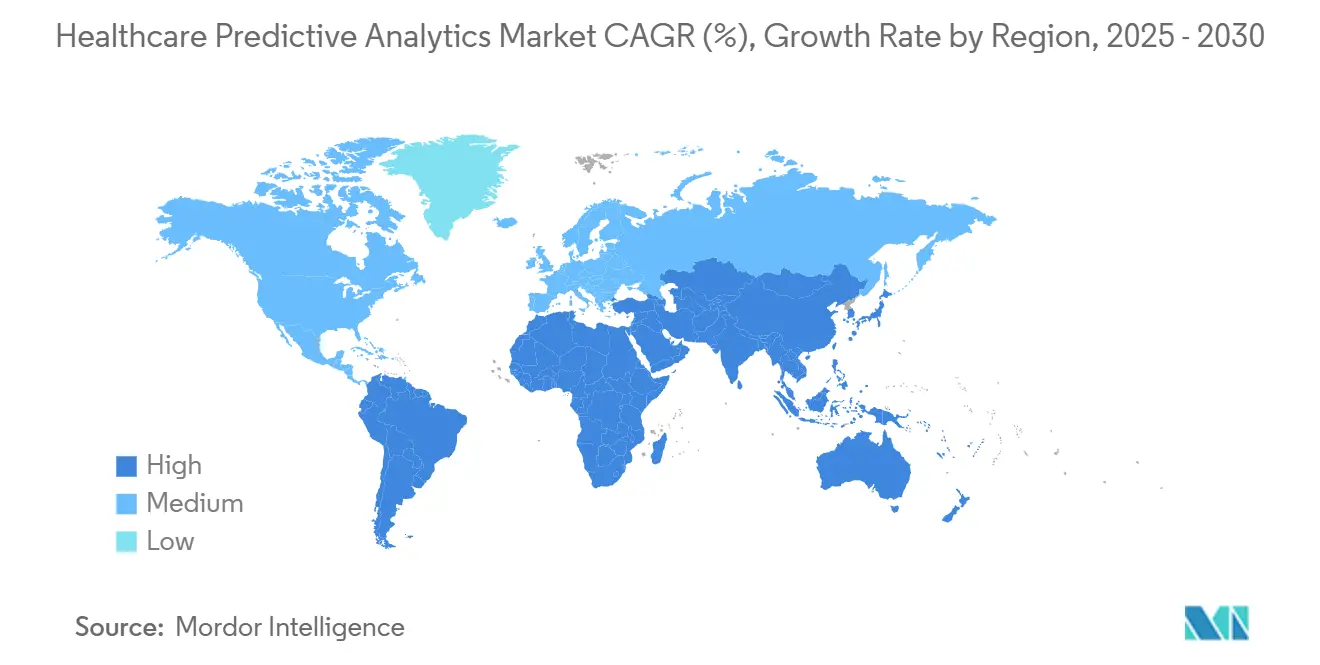
Competitive Landscape
The healthcare predictive analytics market remains moderately fragmented as EHR incumbents, enterprise software giants, and niche start-ups pursue overlapping roadmaps. Epic Systems embeds more than 100 predictive models into its core platform, serving over 400 health systems. Oracle Health leverages its cloud portfolio to integrate analytics across clinical, financial, and supply-chain modules. Specialty firms such as SAS Institute and Health Catalyst differentiate through advanced feature engineering and visual model explainers.
Start-ups like Lucem Health and MediWhale focus on undiagnosed disease detection using cross-modality inputs, tapping venture funding to refine narrow use cases. Strategic buyers increasingly acquire point solutions to fill capability gaps and present end-to-end suites to hospital executives. FDA lifecycle guidance favors vendors with robust quality management systems, contributing to consolidation.
Technology competition centers on three vectors: inference speed, explainability, and integration. Vendors that deliver sub-second risk scoring, clinician-friendly explanations, and minimal EHR configuration rise to the top of procurement shortlists. Meanwhile, synthetic data partnerships gain prominence as firms seek differentiated training corpora that sidestep privacy hurdles and accelerate rare-event model validation. Overall, switching costs and embedded workflows raise entry barriers, encouraging multi-year platform commitments.
Healthcare Predictive Analytics Industry Leaders
-
Cerner Corporation
-
Information Builders Inc.
-
International Business Machines Corporation (IBM)
-
Oracle Corporation
-
Health Catalyst
- *Disclaimer: Major Players sorted in no particular order
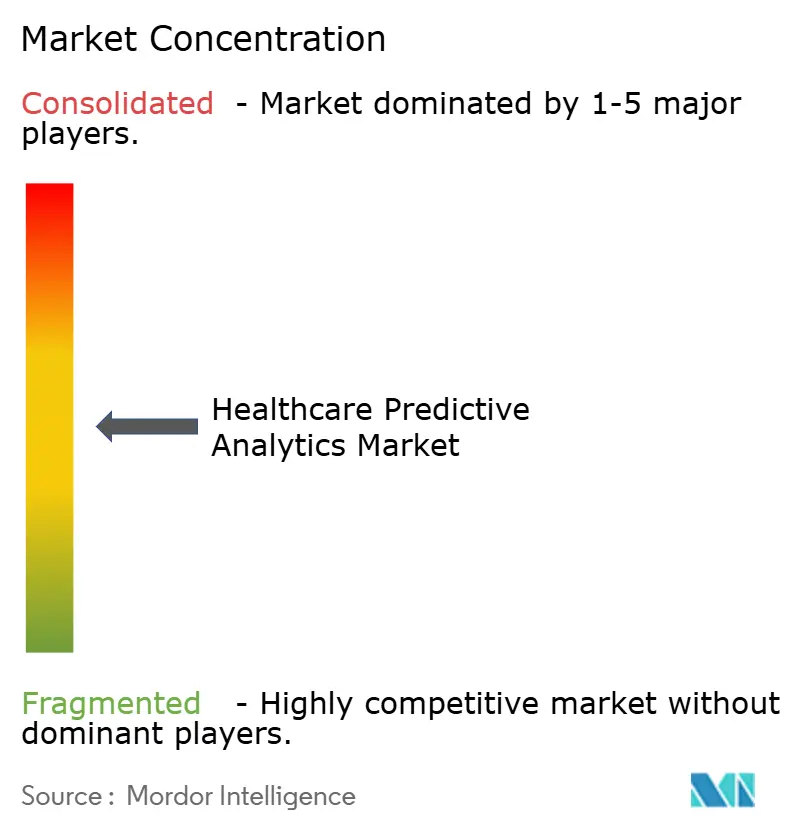
Recent Industry Developments
- January 2025: FDA released comprehensive draft guidance titled "Artificial Intelligence-Enabled Device Software Functions: Lifecycle Management and Marketing Submission Recommendations," providing regulatory clarity for AI-enabled medical device development and establishing total product lifecycle approach requirements for predictive analytics applications.
- January 2025: FDA issued draft guidance on "Considerations for the Use of Artificial Intelligence To Support Regulatory Decision-Making for Drug and Biological Products," proposing risk-based credibility assessment framework for AI models used in pharmaceutical development and regulatory submissions.
- December 2024: Epic Systems announced 20 new programs focusing on AI integration and patient experience enhancement, including AI-powered MyChart agents for personalized patient guidance and expanded predictive analytics capabilities across over 400 health systems.
- May 2024: Mayo Clinic implemented Opmed.ai's AI solution for cardiac surgery scheduling optimization, achieving 34-minute mean absolute error reduction in case duration predictions and saving over 200 operating room hours annually.
Research Methodology Framework and Report Scope
Market Definitions and Key Coverage
Our study treats the healthcare predictive analytics market as all software and service revenues derived from algorithms that use historical and real-time clinical, operational, financial, and social-determinant data to forecast events such as disease progression, readmission risk, staffing needs, and fraud exposure.
The lens excludes generic data-warehouse tools, descriptive dashboards, and AI platforms whose outputs remain purely retrospective.
Segmentation Overview
- By Application
- Clinical Data Analytics
- Financial Data Analytics
- Research Data Analytics
- Operations & Supply-Chain Management
- Other Niche Applications
- By Analytics Type
- Descriptive
- Predictive
- Prescriptive
- Cognitive
- By Component
- Software
- Services
- Hardware
- By Mode of Delivery
- On-Premise
- Cloud-Based
- Hybrid
- By Geography
- North America
- United States
- Canada
- Mexico
- Europe
- Germany
- United Kingdom
- France
- Italy
- Spain
- Rest of Europe
- Asia-Pacific
- China
- Japan
- India
- Australia
- South Korea
- Rest of Asia-Pacific
- Middle East & Africa
- GCC
- South Africa
- Rest of Middle East & Africa
- South America
- Brazil
- Argentina
- Rest of South America
- North America
Detailed Research Methodology and Data Validation
Primary Research
Mordor analysts conduct structured calls with hospital CIOs, payer analytics leads, and cloud-platform integrators in North America, Europe, and Asia Pacific, confirming live user counts, model refresh cadences, and typical pay-per-use fees that are invisible in public filings.
These interviews validate desk assumptions and surface regional cost differentials before figures are triangulated.
Desk Research
We screen open sources, such as US CMS Hospital Compare, Eurostat health expenditure files, WHO Global Health Observatory, and trade association briefs from HIMSS and AHIP, to map data flows and adoption rates across provider and payer settings.
Company 10-Ks, IPO prospectuses, and vendor price lists enrich average selling price (ASP) benchmarks, while D&B Hoovers and Dow Jones Factiva supply hard revenue traces for key suppliers.
Patent analytics from Questel highlight emerging risk-scoring techniques, and import records via Volza uncover regional deployment skews.
The sources cited are illustrative; many additional data sets inform our desk work.
Market-Sizing & Forecasting
A top-down demand pool is built from provider and payer IT budgets, then narrowed by analytics penetration ratios and average per-facility spend; selective bottom-up checks using sampled vendor revenues and channel inquiries adjust totals.
Key variables like EHR penetration, value-based reimbursement share, cloud-migration rate, average model-refresh frequency, and regulatory incentives drive both current sizing and CAGR.
Multivariate regression links these inputs to historical spend, while scenario analysis tests upside from Gen-AI deployment.
Data voids in bottom-up samplings are bridged through interpolation anchored to peer clusters.
Data Validation & Update Cycle
Outputs pass anomaly screens, peer cross-checks, and senior analyst reviews.
Models refresh each year, and interim client alerts trigger if funding cycles, major M&A, or regulatory shifts materially alter any driver set.
Why Mordor's Healthcare Predictive Analytics Baseline Commands Confidence
Published values vary because firms choose different inclusion rules, price capture points, and refresh rhythms.
Our disciplined scope and yearly recalibration narrow those gaps for decision-makers.
Benchmark comparison
| Market Size | Anonymized source | Primary gap driver |
|---|---|---|
| USD 20.31 B (2025) | Mordor Intelligence | - |
| USD 18.49 B (2024) | Global Consultancy A | Bundles operations analytics and counts descriptive tools |
| USD 16.75 B (2024) | Industry Data Publisher B | Uses vendor revenue sampling only and applies aggressive dollar-based escalation without adjusting for value-based reimbursement |
The comparison shows how scope creep or single-method models can swing totals by several billion dollars, whereas Mordor's blended approach, multi-source cross-validation, and annual refresh deliver a stable, transparent baseline clients can rely on.
Key Questions Answered in the Report
What is the current value of the healthcare predictive analytics market?
The market is valued at USD 20.31 billion in 2025 and is projected to reach USD 69.84 billion by 2030.
Which application area is growing the fastest?
Clinical data analytics is forecast to expand at a 30.52% CAGR through 2030 as providers focus on outcome improvement.
How quickly are cloud-based deployments growing?
Cloud solutions are advancing at a 34.71% CAGR because elastic compute accelerates model training and real-time inference.
Why is Asia-Pacific considered a growth epicenter?
Government-backed digitization programs and rapid AI adoption give the region a projected 31.71% CAGR through 2030.
What are the primary barriers to adoption?
Limited enterprise-grade data infrastructure and shortages of analytics-savvy clinicians constrain near-term implementation.
How are regulators influencing market growth?
FDA lifecycle guidance released in 2025 provides clarity on AI device submissions, encouraging responsible innovation.
Page last updated on:
